"The upcoming Ethereum bull market will completely ignite the market."
Written by: Arthur Hayes
Translated and organized by: BitpushNews

Unveiling Trump's "Fascist Economy" and the Secret Waltz of the Crypto Bull Market — The deadly dance of Bitcoin and the "Credit Drum," are your investment moves keeping up?
The highest praise humanity can give to the universe is the joy born from dance. Most religions incorporate some form of music and dance into their worship rituals. The House Music I believe in, the place where it "moves your body," is not the church on Sunday morning, but the dance floor at Club Space during the same time.
In college, I joined the ballroom dance club, using my body to praise the rhythm. Each ballroom dance has strict rules (for example, in the rumba, you cannot place your weight on a bent leg), and for beginners, the hardest part is to dance the basic steps in time with the beat. The biggest challenge is to first determine the tempo of a song, and then know where each beat falls.
My favorite ballroom dance — the country dance — is in 4/4 time; while the waltz is in 3/4 time. Once you know the tempo, your ears must catch which instrument is on the accent and count the remaining beats of the measure. If every piece of music just had the bass drum pounding "one, two, three, four," it would be very monotonous and boring. The allure of music lies in how composers and producers layer other instruments and sounds to add depth and richness to the song. But when dancing, listening to all these secondary sounds is unnecessary for placing your feet in the right position at the right time.
Like music, price charts are fluctuations of human emotions, and our portfolios dance along with them. Just like ballroom dancing, our decisions to buy and sell different types of assets must follow the tempo and rhythm of specific markets. If we fall out of rhythm, we will lose money. Losing money, like a dancer out of rhythm, is ugly. So the question arises: if we want to remain beautiful and wealthy, which instrument in the financial market must our ears listen to?
If my investment philosophy has an unspoken core idea, it is this: the most important variable in profitable trading is understanding how fiat currency supply changes.
For cryptocurrencies, this is even more critical because, at least for Bitcoin, it is a fixed supply asset. Therefore, the speed of fiat currency supply expansion determines the speed at which Bitcoin's price rises. Since early 2009, massive amounts of fiat currency have been created, competing for relatively insignificant Bitcoin supply, making Bitcoin the best-performing fiat-denominated asset in human history.
Currently, the jarring sounds emitted by financial and political events form a tritone. The market continues to rise, but there are some very serious, seemingly negative catalysts creating dissonance. Should you hedge in place due to tariffs and/or war? Or are these just unnecessary instruments? If so, can we hear the guiding force of the bass drum — that is, credit creation?
Tariffs and wars are important because a single instrument or sound can ruin a piece of music. But these two issues are interconnected and ultimately unrelated to Bitcoin's continued rise. U.S. President Trump cannot impose meaningful tariffs on China because China will cut off rare earth supplies to the "beautiful country" and its vassal states. Without rare earths, the U.S. cannot manufacture weapons to sell to Ukraine or Israel. Thus, the U.S. and China are engaged in a crazy tango, both probing each other to avoid overly shaking the foundation economically or geopolitically. This is why the status quo, although sad and deadly for people in both places, will not have a substantial impact on the global financial market at present.
Meanwhile, the credit bass drum continues to delineate time and rhythm. The U.S. needs industrial policy, which is a euphemism for state capitalism, technically referred to as that dirty word: fascism. The U.S. needs to shift from a semi-capitalist economic system to a fascist economic system because its industrial giants cannot produce war materials in sufficient quantities to cope with the current geopolitical environment based on their own will.
The war between Israel and Iran lasted only twelve days because Israel exhausted the missiles supplied by the U.S. and could not operate its air defense system perfectly. Russian President Putin is indifferent to the threats posed by the U.S. and NATO's deepening support for Ukraine because they cannot produce weapons at the same quantity, speed, and low price as Russia.
The U.S. also needs a more fascist economic arrangement to boost employment and corporate profits. From a Keynesian perspective, war is very beneficial to the economy. The public's stagnant organic demand is replaced by the government's insatiable demand for weapons.
Ultimately, the banking system is also willing to provide credit to businesses because they are guaranteed profits by producing products needed by the government. Wartime presidents are very popular, at least at first, because everyone seems to become wealthier. If we take a more comprehensive approach to measuring economic growth, it becomes very clear that war is extremely destructive in net benefits. But that kind of thinking does not win elections, and the primary goal of every politician is re-election, if not for themselves, then for their party members. Trump is a wartime president, like most of his American predecessors, and thus he is placing the U.S. economy in a wartime state. This makes finding the rhythm easier; we must look for ways in which credit is injected into the economy.
In my article "Black or White," I explained how government-guaranteed profits lead to "key" industries receiving bank credit. I call this policy "Quantitative Easing for Poor People" (QE 4 Poor People), which creates a fountain of credit. I predicted this would be the way Trump's team would boost the U.S. economy, and the deal with MP Materials is our first large-scale real-world case.
The first part of this article will explain how this deal expands the dollar credit supply and will become the template followed by the Trump administration in attempting to produce the key goods needed for 21st-century warfare (semiconductors, rare earths, industrial metals, etc.).
War also requires the government to continue borrowing massive amounts of money. Even if the assets of the rich swell due to increased credit supply leading to higher capital gains tax revenue, the government will still face an expanding fiscal deficit. Who will buy this debt? Stablecoin issuers.
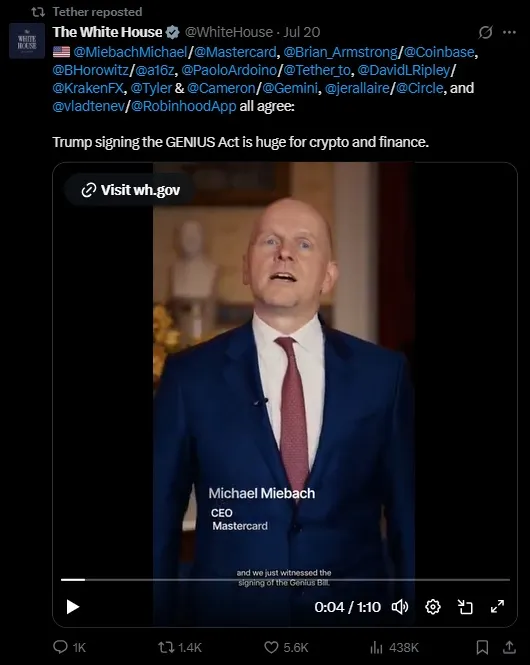
As the total market value of cryptocurrencies rises, a portion of it will be stored in the form of stablecoins. The vast majority of these stablecoins' assets under custody (AUC) are invested in U.S. Treasury bills.
Therefore, if the Trump administration can provide a favorable regulatory environment for traditional finance (TradFi) to participate in and invest in cryptocurrencies, the total market value of cryptocurrencies will soar. Then the custodial assets of stablecoins will automatically increase, creating more purchasing power for Treasury bills. U.S. Treasury Secretary Bessent will continue to issue Treasury bills far exceeding Treasury notes or bonds for stablecoin issuers to purchase.
Let’s dance a credit waltz, and I will guide readers on how to perfectly execute the S serpentine step.
Quantitative Easing for Poor People (QE 4 Poor People)
Central bank money printing does not create a powerful wartime economy. Finance has replaced rocket engineering. To correct this failure of wartime production, the banking system is encouraged to provide credit to industries deemed critical by the government, rather than to corporate raiders.
American private enterprises aim for profit maximization. Since the 1970s, engaging in "knowledge" work within the U.S. while pushing production overseas has been more profitable. China is very willing to enhance its manufacturing skills by becoming the world's low-cost, and over time, high-quality manufacturing factory. However, producing a $1 Nike does not threaten the elites of the "beautiful country." The real problem is that at a time when the "beautiful country" is severely threatened in its hegemony, it cannot produce war materials. Hence, all the fuss about rare earths arises.
Rare earths are not rare, but they are difficult to process, largely due to significant environmental externalities and huge capital expenditure requirements. Over 30 years ago, Chinese leader Deng Xiaoping decided that China would dominate rare earth production, and this foresight can now be leveraged by current leaders. Currently, all modern weapon systems require rare earths; therefore, it is China, not the U.S., that decides how long the war lasts. To correct this situation, Trump is drawing on China's economic system to ensure that U.S. rare earth production increases so he can continue his belligerent behavior.
Here are the key points from Reuters about the MP Materials deal:
- The U.S. Department of Defense will become the largest shareholder of MP Materials.
- This deal will boost U.S. rare earth production and weaken China's dominance.
- The Department of Defense will also provide a floor price for key rare earth products.
- The floor price will be twice the current market price in China.
- Following the announcement, MP Materials' stock price surged nearly 50%.
All of this is great, but where does the funding for building the factory come from?
MP Materials stated that JPMorgan and Goldman Sachs are providing a $1 billion loan to build its tenfold capacity factory.
Why are banks suddenly willing to lend to the real industry? Because the U.S. government guarantees that this "money-burning project" is profitable for borrowers. The T-account below explains how this deal creates credit out of thin air, leading to economic growth.

MP Materials (MP) needs to build a rare earth processing plant and obtains a $1,000 loan from JPMorgan. This loan creates $1,000 of new fiat currency (wampum), which is deposited into JPMorgan.
MP Materials then builds the rare earth processing plant. To do this, it needs to hire workers, the "plebes." In this simplified example, I assume all costs consist of labor fees. MP Materials must pay the workers, which leads to a debit of $1,000 from the MP account and a credit of $1,000 to the plebes' accounts at JPMorgan.
The Department of Defense (DoD) needs to pay for these rare earths. The funds come from the Treasury, which must issue debt to finance the DoD. JPMorgan converts its corporate loan asset to MP into reserves held at the Federal Reserve through the discount window. These reserves are used to purchase the debt, leading to a credit to the Treasury General Account (TGA). The DoD then purchases rare earths, which becomes revenue for MP Materials, ultimately returning as deposits to JPMorgan.
The ending balance of fiat currency (EB) is $1,000 higher than the initial loan amount from JPMorgan. This expansion is due to the money multiplier effect.
This is how government procurement guarantees finance the construction of new factories and the hiring of workers through commercial bank credit. I did not include it in this example, but JPMorgan will now lend to these "plebes" so they can purchase assets and goods (houses, cars, iPhones, etc.) because they have stable, good jobs. This is another example of new credit creation that ultimately ends up in the hands of other American companies, with that income being deposited back into the banking system. As you can see, the money multiplier is greater than 1, and this wartime production leads to increased economic activity, which is counted as "growth."
Money supply, economic activity, and government debt all grow in sync. Everyone is happy. The "plebes" have jobs, and financiers/entrepreneurs have government-guaranteed profits. If these fascist economic policies can provide benefits out of thin air for everyone, why hasn't this become the global economic policy for every nation-state? Because it would cause inflation.
The human resources and raw materials needed to produce goods are limited. By encouraging the commercial banking system to create money out of thin air, the government is crowding out financing and ultimately production of other goods. In the end, this will lead to shortages of raw materials and labor. However, fiat currency is not in short supply. Therefore, wage and commodity inflation will follow, ultimately causing pain for any individual or entity that is not directly connected to the government or the banking system. If you don't believe me, read the daily history of the two world wars.
The MP Materials deal is the first large-scale, significant case that embodies the "Quantitative Easing for Poor People" policy. The best part of this policy is that it does not require congressional approval. The Department of Defense, under the direction of Trump and his successor in 2028, can issue guaranteed procurement orders as part of its normal business process. Profit-seeking banks will follow suit, fulfilling their "patriotic" duty to provide funding for those businesses attached to the government. In fact, elected representatives from all parties will rush to argue why companies in their constituencies should receive procurement orders from the Department of Defense.
If we know that this form of credit creation will not face political resistance, how can we protect our portfolios from the ensuing inflation?
Blowing Bubbles, Trying to Inflate
Politicians are not unaware that stimulating "key" industries by accelerating credit growth will cause inflation. The challenge lies in utilizing the excess credit to inflate a bubble in an asset that will not disrupt social stability. If the price of wheat were to soar like Bitcoin has over the past 15 years, most governments could be overthrown by popular revolution. Instead, the government encourages the public (who instinctively feel their real purchasing power is declining) to share in the credit game by investing in state-recognized inflation-hedging assets to profit.
Let’s look at a real-world example outside of crypto, back to China. China is the best example of a fascist economic system. Since the late 1980s, their banking system has created the largest amount of credit in the shortest time in civilized human history, primarily allocating it to state-owned enterprises. They have successfully become the world's low-cost, high-quality factory; currently, one-third of the world's manufactured goods come from China. If you still think the products made by Chinese companies are of poor quality, go test drive a BYD and then a Tesla.
China's money supply (M2) has grown by 5000% from 1996 to now. The "plebes" hoping to escape this credit-driven inflation face very low bank deposit interest rates. As a result, they have flooded into apartments, and the government has encouraged this behavior as part of its urbanization strategy. Rising housing prices, at least until 2020, helped suppress the public's demand to hoard other physical goods. Housing prices in China's first-tier cities (Beijing, Shanghai, Shenzhen, Guangzhou) have become the most expensive in the world when calculated by affordability.
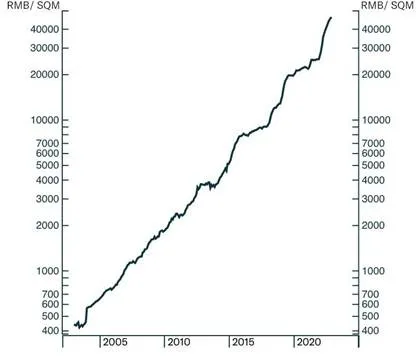
Land prices have increased 80 times over 19 years, with a compound annual growth rate (CAGR) of 26%.
This housing price inflation has not disrupted social stability because ordinary middle-class citizens can borrow money to purchase at least one apartment. Therefore, everyone is involved. An extremely important secondary effect is that local governments primarily fund social services by selling land to developers, who then build apartments to sell to the "plebes." As housing prices rise, land prices and sales also increase, leading to higher tax revenues.
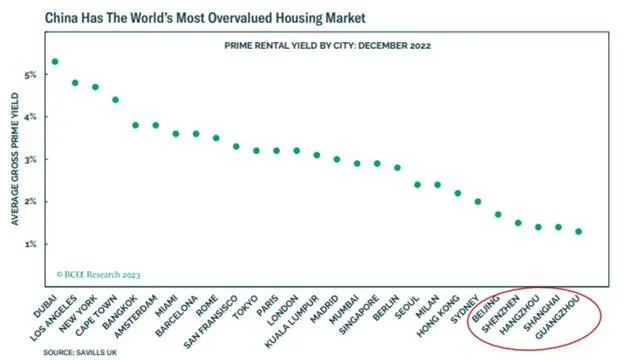
This case tells us that if the Trump administration truly intends to fully implement economic fascism, then the excess credit growth must inflate a bubble that allows ordinary people to profit while simultaneously funding the government.
The bubble that the Trump administration will inflate will focus on the cryptocurrency sector.
Before I delve into how the crypto bubble can achieve various policy goals of the Trump administration, let me first explain why Bitcoin and cryptocurrencies will soar as the U.S. becomes a fascist economy.
I created a custom index on the Bloomberg terminal called .BANKUS U Index> (white line). This is the total of bank reserves held by the Federal Reserve and other deposits and liabilities in the banking system, serving as a proxy for loan growth. Bitcoin is the gold line, and both lines are indexed to 100 as of January 2020. Credit growth has doubled, and Bitcoin has increased 15 times. The fiat price of Bitcoin has a highly leveraged effect on credit growth.
At this point, neither retail nor institutional investors can deny that if you believe more fiat currency will be created in the future, Bitcoin is the best investment choice.
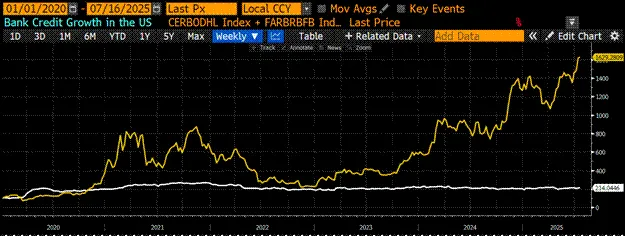
Trump and Bessent have also been "orange-pilled." From their perspective, the best thing about Bitcoin and the entire cryptocurrency space is that, compared to the wealthy white baby boomer generation, traditionally non-stock-holding demographics (young people, the poor, and non-whites) have a higher proportion of cryptocurrency ownership. Therefore, if cryptocurrencies thrive, it will create a broader and more diverse group of people who feel satisfied with the ruling party's economic platform.
Additionally, to encourage all types of savings to invest in cryptocurrencies, a recent executive order explicitly allows 401(k) retirement plans to invest in crypto assets. These plans hold about $8.7 trillion in assets. Boom Shak-A-Laka!
The killer blow is President Trump’s proposal to eliminate capital gains tax on cryptocurrencies. Trump is offering war-driven crazy credit growth, regulatory permission for retirement funds to put cash into cryptocurrencies, and — TMD, no taxes! Hooray!
All of this is great, but there is one problem. The government must issue more and more debt to fund the procurement guarantees provided to private enterprises by the Department of Defense and other agencies. Who will buy this debt? Cryptocurrencies win again.
Once capital enters the crypto capital markets, it typically does not leave. If an investor wants to sit on the sidelines, they can hold stablecoins pegged to the dollar, like USDT.
USDT invests in the safest traditional finance (TradFi) yield-generating instruments: Treasury bills, to earn returns from its custodial assets. Treasury bills have maturities of less than a year, so interest rate risk is close to zero, and they are liquid like cash. The U.S. government can print dollars infinitely for free, so nominal default will never occur. Currently, Treasury bills yield between 4.25% and 4.50%, depending on the maturity. Therefore, the higher the total market value of cryptocurrencies, the more funds stablecoin issuers accumulate. Ultimately, most of these custodial assets will be invested in Treasury bills.

On average, for every $1 increase in the total market value of cryptocurrencies, $0.09 flows into stablecoins. Let’s assume Trump diligently pushes the total market value of cryptocurrencies to $100 trillion by the time he leaves office in 2028. This is about a 25-fold increase from current levels;
If you think this is impossible, it shows you haven't been in touch with cryptocurrencies long enough. This will create about $9 trillion in Treasury bill purchasing power, realized through global capital inflows by stablecoin issuers.
From a historical perspective, when the Federal Reserve and the Treasury needed to fund America's World War II adventures, they also resorted to issuing far more Treasury bills than bonds.
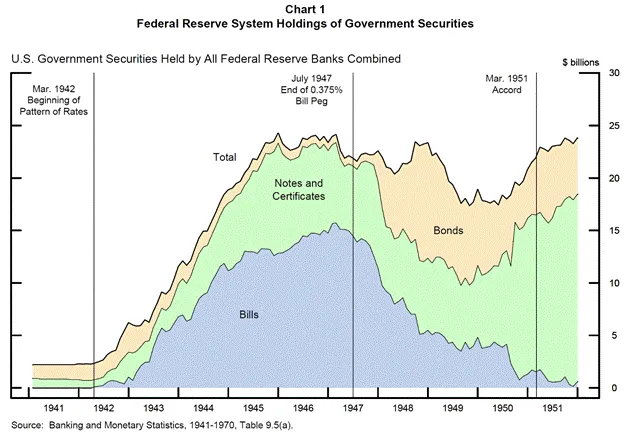
Now, Trump and Bessent have "solved the puzzle":
They replicated the Chinese model, creating a U.S. fascist economic system to produce materials.
The inflationary impulse of financial assets triggered by credit growth is directed towards cryptocurrencies, which soar, making the general public feel wealthier due to their astonishing returns. They will vote for the Republican Party in 2026 and 2028… unless they have a teenage daughter… or maybe the public always votes with their wallets.
The continuously rising crypto market brings a massive influx of funds into stablecoins pegged to the dollar. These issuers will invest their custodial assets in newly issued Treasury bills, funding the ever-expanding federal deficit.
The bass drum is beating. Credit is being pumped. Why haven’t you fully invested in cryptocurrencies yet? Don’t fear tariffs, don’t fear war, and don’t fear randomly occurring social issues.
Trading Strategy
It’s simple: Maelstrom is fully invested. Because we are degens, the altcoin space offers incredible opportunities to outperform Bitcoin, the crypto reserve asset.
The upcoming Ethereum bull market will completely ignite the market.
Since Solana surged from $7 to $280 from the ashes of FTX, Ethereum has been the least favored among large cryptocurrencies. But now it’s different; the Western institutional investor group, led by cheerleader Tom Lee, is very fond of Ethereum.
Buy first, ask questions later. Or don’t buy, and then like a gloomy guy, drink tasteless light beer that tastes like urine in the corner of the club while a group of people you think are less intelligent than you spend lavishly on champagne at the table next to you.
This is not financial advice, so decide for yourself. Maelstrom is doing everything about Ethereum, everything about DeFi, and everything driven by ERC-20 altcoin "degenerates."
My year-end targets:
Bitcoin = $250,000
Ethereum = $10,000
Yacht freedom, TMD!
免责声明:本文章仅代表作者个人观点,不代表本平台的立场和观点。本文章仅供信息分享,不构成对任何人的任何投资建议。用户与作者之间的任何争议,与本平台无关。如网页中刊载的文章或图片涉及侵权,请提供相关的权利证明和身份证明发送邮件到support@aicoin.com,本平台相关工作人员将会进行核查。




